MENU
MENU
Tea production area: Ogaki City, Tarui Town, Sekigahara Town, Ebigawa Town, Ikeda Town, Shirakawa Town, Higashi Shirakawa Village, Hichiso Town and Yaotsu Town
Brand name of tea: Mino Ibi tea, Mino Shirakawa tea
Types of tea: Sencha (medium steamed green tea), fukamushicha (deep steamed green tea), kukicha (stem tea), hojicha (roasted green tea), genmaicha (popped rice green tea), gyokuro (high quality shaded tea), kabusecha (shaded green tea), black tea, bancha, powdered tea, etc.
Mino tea
Tea cultivated and produced in the Mino Region is called Mino tea collectively. Mino tea includes Mino Ibi and Mino Shirakawa tea.
Tea of the Gif Prefecture has a long history. It is said that Mino tea was born as Goyo-bancha which was the bancha presented to the Tokugawa shogunate during the Edo Period.
There is a road called the “Nishi Mino Ochakaido (West Mino Tea Road)” in Ibikawa Town. There are many sprawling tea fields alongside the road.
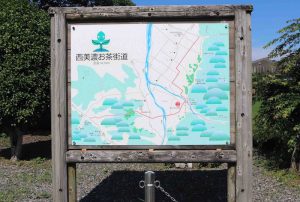
A signboard of Nishi Mino Ochakaido (Nishi Mino tea road) in Ibikawa Town (July 2019)
Mino Ibi tea
Mino Ibi tea is produced in Ibikawa Town located west part of the Gifu Prefecture. Various types of teas are produced in the lowlands in Ibikawa Town.
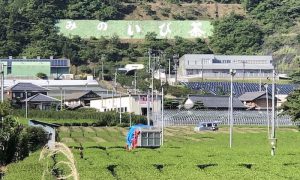
Tea fields in Ibikawa Town (July 2019)
Japanese tea café, Ibichanosato (いび茶の里)
Ibichanosato of Ibikawa Town is a Japanese tea café there. You can have Ibikawa tea and sweets made from Ibikawa tea, and also buy tea and locally made food at the café.
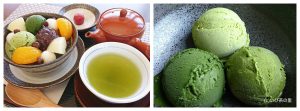
Photo on left: Matcha anmitsu (抹茶あんみつ), photo on right: Matcha ice cream
Photos provided by Ibicha no sato http://www.ibicha-tea.shop
Anmitsu (あんみつ) is a Japanese dessert which consists of small cubes of sweet agar jelly, sweet azuki bean paste, soft rice cake, various fruits and syrup.
Tea fields in the sky
In the mountainous area of Kasugakamigare, Ibikawa Town, tea fields spread from the middle of the mountain to the summit at an altitude of 300 meters.
If you go hiking in a mountain along the walking path of Tenkunoyufodo (天空の遊歩道), you can see the tea fields spreading out below you. The tea fields will look as if they are in the sky.
At times the walking path is closed for maintenance. Before visiting there, please confirm with the online site of Ibikawa Town.
https://www.town.ibigawa.lg.jp
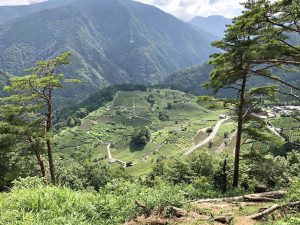
Tea fields in Ibikawa Town (July 2019)
Bancha of Kasuga Village
Bancha has been produced for many years in the mountain region of Ibikawa Town. Tea branches with leaves for bancha are plucked in July or August after the first and second picking. These branches with leaves are cut into 20 to 30 cm lengths and then steamed in a wooden basket over boiling water in a big iron pot. After steaming, these are spread out to dry in the sun.
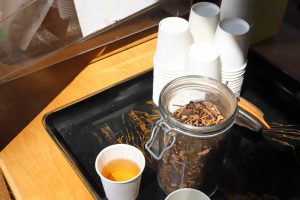
Kasuga bancha in Kasuga Village (July 2019)
Mino Shirakawa tea
Mino Shirakawa tea is produced in Shirakawa Town and Higashi Shirakawa Village. This area is suitable for cultivating tea because of a wide range of temperature and frequent fog. Morning fog is effective for blocking sun light and for retaining heat. It helps in producing tea with Umami and less astringency.
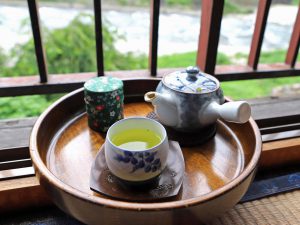
Mino-Shirakawa tea at Naritaya (成田屋) (July 2019)
Guinness World Record for “the most people picking Shirakawa tea leaves at the same time”
An event of “the most people picking Shirakawa tea leaves at the same time” was held in Shirakawa Town on July 7, 2019 when 576 people picked tea leaves at the same time for 5 minutes and it was certified by the Guinness Book of World Record as a world record. The event was held to promote sales and to expand the consumption of Shirakawa tea.
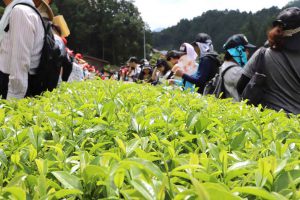
Shirakawacha de Challenge
“Challenge a world record by picking Shirakawa tea” (July 7, 2019)

Memorial tea and certificate commemorating the Guinness World Record
(July 2019)
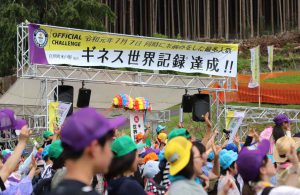
Tea mascot Yuru-Chara:
Chakiemon 茶桧右ヱ門 (Shirakawa Town)
Chako 茶子 (Shirakawa Town)
Chachamaru (Ikeda Town)
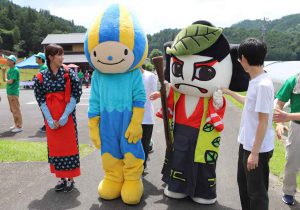
Photo from left, a tea picking girl, Sirakawa minamo and Chakiemon
at the event of Challenge a world record by picking Shirakawa tea (July 2019)
Tea related event:
Tea related facilities:
岐阜県揖斐川町春日上ヶ流天空の遊歩道
https://www.town.ibigawa.lg.jp
https://www.town.ibigawa.lg.jp/kankoujyouhou/0000006832.html
いび茶の里 http://www.ibicha-tea.shop
道の駅 美濃白川ピアチェーレ https://roadside-minoshirakawa.co.jp
道の駅茶の里東白川 http://chanosato.gifu.jp
Ceramic and pottery art: Mino ware
Bancha (番茶・晩茶):
Originally bancha meant coarse tea, in contrast to sencha (medium-steamed green tea). Sencha is produced with new, tender tea leaves which are plucked during the first tea harvest season in Japan. Bancha is made from matured, hard tea leaves and stems, plucked during the late part of the first tea harvest or in autumn. Shuto bancha (秋冬) is steamed green tea, produced from tea leaves plucked during the autumn and early winter.
Additionally, bancha is used for local, special teas, such as Sado bancha of Nigata Prefecture, Mimasaka bancha of Okayama Prefecture, Awa bancha of Tokushima Prefecture, Kyo bancha of Kyoto Prefecture, and so on, but each production method differs.
Reference:
松下智 (平成3年) 日本名茶紀行 (初版) 雄山閣出版
高野實・谷本陽蔵・富田勲・中川致之・岩浅潔・寺本益英・山田新市 (2005) 緑茶の事典 (改訂3版) 柴田書店
大森正司、阿南豊正、伊勢村護、加藤みゆき、滝口明子、中村羊一郎編(2017) 茶の事典 初版第一刷 朝倉書店
岐阜県 岐阜県のお茶【美濃茶】
www.pref.gifu.lg.jp/sangyo/nogyo/nosanbutsu/11423/index_12583.html
揖斐川町春日上ヶ流天空の遊歩道
www.town.ibigawa.lg.jp/kankoujyouhou/0000006832.html
美濃白川茶、白川町茶業振興会 https://shirakawa-cha.weebly.com
白川観光協会 http://kankou.town.shirakawa.gifu.jp
白川茶de茶レンジ https://shirakawachadecharenji.jimdofree.com
*When visiting the shops and facilities introduced in this article, please check the business hours on their website, etc. before visiting.
*The information provided on this site may be updated. If you find any information in this article that is incorrect, new, or incomplete, please contact CHAMART.
*The site does not describe all “Teas of Japan” or all “Teas of the World”. Additionally, each article expresses the writer’s personal experience and feelings.
#Gifu #Minotea #Japanesetea